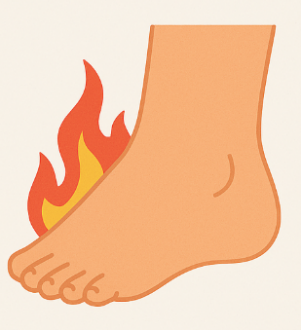Information
Sensory symptoms are one of the commonest issues for which we provide advice to primary care. This advice sheet is to support GPs and patients when faced with burning and tingling in the feet/extremities, to supplement existing advice about idiopathic axonal neuropathy, restless legs syndrome, and benign sensory symptoms.
Sensory disturbance does not mean ‘peripheral neuropathy’

Disturbed sensation of extremities (e.g. tingling, numbness, crawling, pain, burning, etc), most commonly of the feet but sometimes spreading more proximally and/or involving the hands, is a common reason for referral to neurology. It is often more noticeable at night, disturbing sleep.
These symptoms are often referred to by non-neurologists as “peripheral neuropathy”, but this is a specific diagnosis and only accounts for some of the people affected. We encourage doctors not to use the term “Peripheral neuropathy” unless confirmed as the cause. Peripheral neuropathy is almost never the likely cause when symptoms are intermittent.
‘Idiopathic’ is the commonest cause
In our experience, “no identifiable cause (idiopathic)” is the most common cause. Sensory symptoms, especially burning/pain, are commonly worse at night or on walking. Causes, in order of frequency, include:
- Idiopathic
- Peripheral neuropathy (most commonly idiopathic axonal neuropathy in over 65s)
- Lumbar spinal stenosis and radiculopathy
- Restless Legs Syndrome (RLS). Burning sensation may complicate RLS, so asking about motor restlessness is sensible. Some cases may also involve involuntary movement of toes – “Painful legs and moving toes syndrome”.
- Small fibre neuropathy (including related to diabetes or alcohol). This doesn’t show on nerve conduction studies, and skin biopsy to look at nerve fibre density is not a reliable way to make the diagnosis. It’s therefore a clinical diagnosis, and the management is symptomatic.
- Ill-fitting footwear, skin problems (eg tinea)
- Complex regional pain syndrome is a chronic nociplastic pain syndrome which can involve burning and redness, typically after injury. Erythromelalgia is a poorly understood condition that causes redness of the feet. It can overlap with complex regional pain syndrome.
Diagnosis and examination
Diagnosis is clinical. Examination is rarely helpful, but look for positive evidence of a neuropathy, e.g. loss of ankle jerks, and distal motor weakness.
Do they need investigation in primary care?
A peripheral neuropathy blood screen is sensible (see Axonal neuropathy advice page on Refhelp), adding a ferritin if concerns about restless legs syndrome (see RLS advice page on Refhelp).
Do they need to see a Neurologist?
Not usually, but we are happy to discuss is you have concerns.
If symptoms are confined to the toes/feet, we will usually provide advice rather than arrange an appointment.
General Lifestyle Advice
As the symptoms often trouble people mostly at night, careful attention to sleep hygiene is important, restricting alcohol/caffeine intake, managing stress, optimising the bedroom environment, etc.
Medical treatment
Neuropathic pain drugs only help neuropathic pain (and even then, only sometimes). There are no drugs that help numbness or tingling, although we commonly find that drugs are mistakenly prescribed for these symptoms.
If there is pain strongly suggesting a neuropathic cause, then consider the usual options (gabapentin, pregabalin, duloxetine, tricyclics, etc), but success is often limited, and withdraw unless there is persisting, unequivocal benefit.













